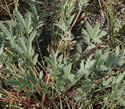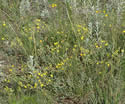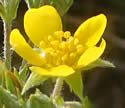Potentilla hippiana (Woolly Cinquefoil)
| Also known as: | Horse Cinquefoil |
|---|---|
| Genus: | Potentilla |
| Family: | Rosaceae (Rose) |
| Life cycle: | perennial |
| Origin: | native |
| Habitat: | sun; dry sandy or rocky soil; prairies, plains, meadows, forest, tundra |
| Bloom season: | June - July |
| Plant height: | 4 to 20 inches |
| Wetland Indicator Status: | none |
| MN county distribution (click map to enlarge): |  |
| National distribution (click map to enlarge): |  |
Pick an image for a larger view. See the glossary for icon descriptions.
Detailed Information
Flower: 

![[photo of flowers]](/udata/r9ndp23q/yellow/potentilla-hippiana-woolly-cinquifoil_0707_104355-t.jpg) Branching cluster at the top of the stem. Flowers are yellow, about ½ inch across, with 5 broad petals that are tapered at the base and rounded, straight across, or slightly depressed at the tip. In the center are about 20 yellow stamens.
Branching cluster at the top of the stem. Flowers are yellow, about ½ inch across, with 5 broad petals that are tapered at the base and rounded, straight across, or slightly depressed at the tip. In the center are about 20 yellow stamens.
![[photo of calyx]](/udata/r9ndp23q/yellow/potentilla-hippiana-woolly-cinquifoil_0707_104454-t.jpg) The calyx cupping the flowers has 5 triangular to lance-shaped, sharply pointed sepals that are somewhat shorter than the petals. Behind each petal, alternating with the sepals, is a narrowly lance-elliptic bractlet shorter than the sepals. The calyx and flower stalks are covered in woolly hairs.
The calyx cupping the flowers has 5 triangular to lance-shaped, sharply pointed sepals that are somewhat shorter than the petals. Behind each petal, alternating with the sepals, is a narrowly lance-elliptic bractlet shorter than the sepals. The calyx and flower stalks are covered in woolly hairs.
Leaves and stems: 


![[photo of basal leaf]](/udata/r9ndp23q/yellow/potentilla-hippiana-woolly-cinquifoil_0707_104639-t.jpg) Leaves are mostly basal, pinnately compound with 7 to 13 leaflets, on stalks 1 to 4+ inches (1 to 10+ cm) long. Leaflets are oblong-elliptic in outline, ¾ to 2 inches (to 5 cm) long, the edges with a few to several large teeth or shallow lobes cut usually less than halfway to the midvein. The lowest leaflets are smallest, becoming larger as they ascend the stalk. The 1 to 3 stem leaves are much smaller, the uppermost stalkless or nearly so.
Leaves are mostly basal, pinnately compound with 7 to 13 leaflets, on stalks 1 to 4+ inches (1 to 10+ cm) long. Leaflets are oblong-elliptic in outline, ¾ to 2 inches (to 5 cm) long, the edges with a few to several large teeth or shallow lobes cut usually less than halfway to the midvein. The lowest leaflets are smallest, becoming larger as they ascend the stalk. The 1 to 3 stem leaves are much smaller, the uppermost stalkless or nearly so.
![[photo of leaf underside]](/udata/r9ndp23q/yellow/potentilla-hippiana-pensylvanica_0707_104229-t.jpg) The upper surface is gray-green with long, appressed, silky hairs; the lower surface silvery from dense woolly hairs. Stems are multiple from the base, erect to ascending to spreading, unbranched except in the flower clusters, covered in woolly hairs, and 2 to 4 times as long as the basal leaves.
The upper surface is gray-green with long, appressed, silky hairs; the lower surface silvery from dense woolly hairs. Stems are multiple from the base, erect to ascending to spreading, unbranched except in the flower clusters, covered in woolly hairs, and 2 to 4 times as long as the basal leaves.
Fruit: 

![[photo of fruit]](/udata/r9ndp23q/yellow/potentilla-hippiana-woolly-cinquifoil_0801_140707-t.jpg) The sepals fold up, creating a capsule-like container, and eventually turn dark brown. Inside are many brown seeds, about 1.5 mm long. The old fruiting stems can persist through winter.
The sepals fold up, creating a capsule-like container, and eventually turn dark brown. Inside are many brown seeds, about 1.5 mm long. The old fruiting stems can persist through winter.
Notes:
Woolly Cinquefoil is primarily a species of alpine meadows, mixed conifer forests, aspen stands and grassy slopes, common in the Rocky Mountains with scattered populations in the Great Plains. Minnesota sits on the eastern edge of its range and populations east of here are likely introduced. The handful of state records are all from a small area in Polk County, northwest of Fertile, the first of which dates back to 1900. It still persists in the area, though populations are small. The flowers resemble those of other yellow-flowered Potentilla species, but the leaves are pretty distinctive and should not be confused with the others.
While Potentilla hippiana may indeed be rare in Minnesota, it is only tracked by the DNR due to insufficient information and is not on the official rare species list (yet).
Native Plant Nurseries, Restoration and Landscaping Services ↓
More photos
 Woolly Cinquefoil plant
Woolly Cinquefoil plant Woolly Cinquefoil plant ©Barry Breckling
Woolly Cinquefoil plant ©Barry Breckling leaves are mostly basal
leaves are mostly basal Woolly Cinquefoil habitat
Woolly Cinquefoil habitat flower cluster
flower cluster
Photos by K. Chayka taken in Polk County. Potentilla hippiana plant by Barry Breckling used under CC BY-NC-SA 3.0.
Comments
Have you seen this plant in Minnesota, or have any other comments about it?
on: 2023-08-21 13:08:31
Found this growing in my yard. Firm match on the flowers, leaves (inc. groups of three), and growth behavior (spreading). Very pretty! Will try to encourage it, especially in the garden bed I dig this fall.
on: 2023-08-21 13:53:04
Jason, it seems unlikely this would volunteer in a Stearns County yard. More likely it is one of the other Potentilla species but you can post some images on the Minnesota Wildflowers Facebook page if you'd like to confirm the ID.






